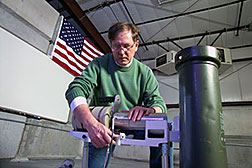- Number 391 |
- June 24, 2013
INL physicist probes dangers using gamma rays

INL's Gus Caffrey demystifies chemical
warfare agents.
Ask A.J. "Gus" Caffrey about his work and you'll get a short history of U.S. chemical warfare agents. The physicist is as passionate about history as he is about his own research, but the military's past is relevant since his signature technology helps demystify it.
At DOE’s Idaho National Laboratory, Caffrey has focused most of his career on “the assessment of dangerous things you’d rather not open.”
In 1992, Caffrey received an R&D 100 Award for inventing a device used around the world today to nondestructively discern the contents of munitions that may contain chemical agents, explosives or other materials. A newer invention that can check the contents of used fuel casks aspires to a similar fate.
Caffrey is best-known for the Portable Isotopic Neutron Spectroscopy (PINS) system; a chemical analysis technology that can reveal the contents of an artillery shell without opening it. After World War I, U.S. soldiers were at risk of exposure while recovering munitions containing a variety of harmful chemical agents such as mustard gas. The problem: the artillery looked identical from the outside, with contents denoted only by paint color-coding and stenciled markings that could fade or corrode over time.
The PINS system shoots energy (in the form of neutrons) at a mystery munition, then measures the energy that emerges (in the form of gamma rays). Because every chemical element reacts differently to the neutrons and emits a different gamma spectrum, PINS software can determine the mix of elements inside.
“By analysis of the gamma rays that come off the artillery shell, you can figure out what chemicals are inside,” Caffrey said.
PINS can distinguish between a host of chemical agents as well as simple explosives, smoke generators and even dummy materials such as plaster of Paris. It accomplishes all this in a matter of minutes using a simple computer interface that keeps the human operator at a safe distance
A more recent invention aiming for similar demand is the Compton Dry-Cast Imaging Scanner (CDCIS), which enables inspectors to determine the contents of a nuclear fuel storage cask without opening it. The scanner was nominated for an R&D 100 Award in 2011. The following year, Caffrey received an INL Lifetime Achievement Award.
But Caffrey's no workaholic and finds plenty of time to savor Idaho's outdoors. He enjoys hiking and rafting in the summer. He picks Idaho huckleberries in the fall. But his real love is powder skiing. He hits the slopes an average of 30 days per winter. And as a 10-year member of the Grand Targhee ski patrol, he's often among the first on the mountain after a snowstorm.
Yet Caffrey shows no inclination to make recreation his full-time job. When asked about retirement plans, he takes a long pause before saying, "I have some interesting new challenges." Then he begins describing a new PINS application he'd like to try.Submitted by DOE's Idaho National Laboratory
